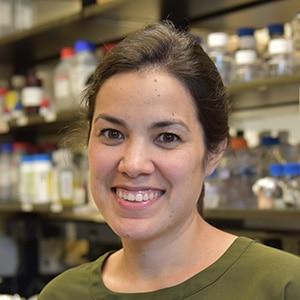Colleagues: Recently Tenured
Meet your recently tenured colleagues: Eli Boritz, NIAID-VRC; Maria Constanza Camargo, NCI-DCEG; Natasha Caplen, NCI-CCR; Peter Grayson, NIAMS; Katherine McJunkin, NIDDK; Richard Scheuermann, NLM; and Joshua Tan, NIAID

ELI BORITZ, M.D. PH.D., NIAID
ELI BORITZ, M.D. PH.D., NIAID
Senior Investigator, Virus Persistence and Dynamics Section, NIAID
Education: Williams College, Williamstown, Massachusetts (B.S. in biology); University of Colorado Health Sciences Center, Denver, Colorado (M.D., Ph.D.)
Training: Internship and residency in Internal Medicine at Johns Hopkins Hospital, Baltimore (2006-2008); joined NIAID as an infectious disease fellow in 2008
Before coming to NIH: Internal medicine resident at Johns Hopkins Hospital
Came to NIH: In 2008 as an infectious disease fellow at NIAID
Outside interests: I became interested in conservation landscaping after receiving a 2019 “RainScapes” grant from Montgomery County, Maryland, to improve my native landscape and water management. I took out my lawn and replaced it with a variety of native plants to attract pollinators, amphibians, and reptiles. I enjoy observing the neighborhood creatures inspecting my handiwork.
Website: https://www.niaid.nih.gov/research/eli-boritz-md-phd-virus-persistence-and-dynamics-section
Research interests: Though antiretroviral therapy in people with HIV can reduce viral load to undetectable concentrations, some CD4 cells still harbor HIV. It’s thought that these cells cause viral rebound in patients who interrupt their antiretroviral therapy. The central question in my research involves these latent cells: What are the attributes of CD4 T cells that harbor HIV in the body, especially during antiretrovirals? These infected CD4 cells show no outward signs of infection, making them undetectable to the immune system, and they can live for decades.
I set out to understand whether there was a way to distinguish these latent HIV-infected CD4 cells from other CD4 cells despite their lack of viral expression. I partnered with engineers at the University of California at San Francisco and the University of California at Berkeley to build a microfluidic technology to describe these cells. They used whole-transcriptome sequencing to find that these CD4-infected T cells had different expression signatures. Specifically, these CD4 cells expressed higher levels of genes involved in regulating transcription of integrated viruses and translation of viral mRNA (PMID: 36599978).
Future research: Moving forward, I hope to continue building my team at NIH. I also am considering expanding my technique to investigate other infectious diseases that involve “invisible” latently infected cells (such as herpes) as well as rare premalignant cells. I hope to continue acting as a mentor to train team members to become experts in this technique. I look forward to expanding on our original trial to investigate more tissues with a larger study population.
COMPILED BY AMELIA MARVIT, NIAID

MARIA CONSTANZA CAMARGO, PH.D, NCI
MARIA CONSTANZA CAMARGO, PH.D, NCI
Senior Investigator, Metabolic Epidemiology Branch, NCI
Education: Universidad Colegio Mayor de Cundinamarca, Bogotá, Colombia (B.Sc. in bacteriology); School of Public Health, Cuernavaca, Mexico (M.S. in epidemiology); Pontificia Universidad Javeriana, Colombia (M.H.A.); University of Illinois at Chicago, Chicago (Ph.D. in public health with concentration in epidemiology)
Training: Postdoctoral fellowship, Infections and Immunoepidemiology Branch, Division of Cancer Epidemiology and Genetics (DCEG), NCI; Earl Stadtman Tenure-Track Investigator, Metabolic Epidemiology Branch, DCEG, NCI
Before coming to NIH: Research associate II (epidemiologist), Department of Pathology, Louisiana State University Health Sciences Center, New Orleans, and research specialist senior (epidemiologist), Division of Gastroenterology, Vanderbilt University Medical Center, Nashville
Came to NIH: In 2008 as a summer fellow during dissertation work at the NCI-DCEG.
Outside interests: Traveling; trying new restaurants; watching movies
Website: https://irp.nih.gov/pi/constanza-camargo
Research interests: I maintain a robust research program with a multidisciplinary team of international collaborators applying cutting-edge molecular epidemiology to the study of Helicobacter pylori and of premalignant and malignant gastric lesions. My portfolio combines studies on gastric cancer causation with projects that may have translational application for cancer screening, prevention, and treatment.
Gastric cancer is a leading cause of cancer death worldwide. In the United States, this neoplasia affects multiple racial and ethnic groups and individuals of lower socioeconomic status. My descriptive studies on incidence trends have shown that gastric cancer is re-emerging, particularly affecting young non-Hispanic white individuals (PMID: 20442388; PMID: 29361173).
Along with colleagues, I recently completed the H. pylori Genome Project, which established a large-scale biobank of clinical H. pylori strains for molecular studies addressing the role of bacterial diversity in the gastric cancer cascade. This publicly available worldwide collection of complete genomes with high-quality metadata will become a major asset for studies of H. pylori pathogenesis and disease outcomes (PMID: 38081806).
Future directions: Ongoing and future work includes 1) identifying potential causal mechanisms driving the increase of gastric cancer in young individuals; 2) comparing H. pylori strains from patients with different gastric diseases to identify genetic and epigenetic bacterial features that determine human pathogenicity; and 3) evaluating potential noninvasive markers for risk stratification and early detection of gastric cancer.
COMPILED BY TAYLOR FARLEY, NIAID

NATASHA CAPLEN, PH.D., NCI-CCR
NATASHA CAPLEN, PH.D., NCI-CCR
Senior Investigator, Functional Genetics Section, Genetics Branch, NCI-CCR
Education: University of Liverpool, Liverpool, England (B.Sc. in genetics); King’s College London, Faculty of Medicine, University of London, London (Ph.D.)
Training: Postdoctoral fellow, St. Mary’s Hospital, Imperial College, University of London, London (1991-1996)
Came to NIH: In 1996 as a visiting fellow, NHGRI
Outside interests: Mystery novels; yoga; traveling
Website: https://irp.nih.gov/pi/natasha-caplen
Research interests: My research background includes contributing to the early development of gene-therapy approaches to treat cystic fibrosis (PMID: 7584951), and while at NHGRI, I conducted studies that demonstrated the presence of the RNA interference (RNAi) pathway in mammalian cells (PMID: 11481446). When I joined NCI-CCR as a senior scientist, my team’s research focused on the development of RNAi-based approaches to investigate the mechanistic basis of different cancer types and the response of cancer cells to approved and investigational drugs (for example, PMID: 21834757).
Our current research focuses on investigating the biology of tumors that depend on the expression of fusion oncogenes derived from genes encoding proteins with functions related to the binding of nucleic acids. The study of these tumor types enables investigation of the fundamental mechanisms that regulate gene expression and contributes to addressing a significant unmet clinical need because many fusion-driven cancers remain challenging to treat. One such tumor type is the aggressive bone and soft tissue malignancy Ewing sarcoma, which typically harbors the fusion oncogene EWSR1::FLI1 or EWSR1::ERG. My group is investigating the function of two heterogeneous ribonucleoproteins (hnRNPs) of importance to Ewing sarcoma biology—HNRNPH1 (PMID: 26776507; PMID: 31511320; PMID: 35639772) and EWSR1 (PMID: 38506112), as well as the mechanisms regulated by the transcriptional activity of EWSR1::FLI1/ERG fusion oncoproteins (PMID: 29873416; PMID: 38588446).
Future research: Our team’s basic research findings will have clinical relevance as it includes the discovery of potentially targetable cancer-specific vulnerabilities and in the long term could uncover prognostic markers of a tumor’s metastatic potential.
COMPILED BY ABIGAIL HOLDER, NIAAA

PETER GRAYSON, M.D., MSC, NIAMS
PETER GRAYSON, M.D., MSC, NIAMS
Senior Investigator, Chief, Vasculitis Translational Research Program and Acting Director, Rheumatology Fellowship Training Program
Education: Brown University, Providence, Rhode Island (A.B. in history); Medical University of South Carolina, Charleston (M.D.); Brown University School of Public Health, Boston (M.Sc. in epidemiology)
Training: Internal medicine residency: Boston Medical Center, Boston; Chief Medical Resident, Boston Medical Center; Rheumatology Fellowship, Boston Medical Center; Vasculitis Fellowship, Vasculitis Clinical Research Consortium, Rare Diseases Clinical Research Network
Before coming to NIH: Assistant professor of medicine, Boston University, Boston
Came to NIH: 2013 as a Lawrence Shulman Scholar in NIAMS
Outside interests: Musician in two NIH-related bands: Affordable Rock n Roll Act and Goldbug Revival
Website: https://irp.nih.gov/pi/peter-grayson
Research interests: I am a rheumatologist who conducts clinical and translational research across many forms of systemic vasculitis. I founded the NIAMS Vasculitis Translational Research Program in 2013, and my group has clinically evaluated >1000 patients with different forms of vasculitis at the Clinical Center. Work from my group has focused on biomarker discovery and development, advanced molecular imaging, molecular classification of disease, clinical trials, and genetics and genomics of vasculitis. In 2020, my group co-discovered the VEXAS syndrome (PMID: 33108101). My group has also worked closely with the radiology and nuclear medicine departments within the Clinical Center to define the use of advanced molecular imaging as a surrogate marker of vascular inflammation in large-vessel vasculitis. My group has conducted some of the only translational work related to relapsing polychondritis, including identifying somatic mutations in UBA1 as a driver of disease in a subset of these patients. Translational work from the group has also defined novel pathways of neutrophil-mediated inflammation in monogenic vasculitis and drug-induced vasculitis and has identified novel biomarkers of disease activity in many forms of vasculitis that suggest novel therapeutic targets.
Future directions: Our group is interested in defining the causal role of somatic mutations and clonal populations of cells in blood and tissue across a spectrum of inflammatory vascular diseases. We are also interested in exploring how novel radioligands and newer technologies related to positron emission tomography can serve as imaging-based surrogates to histology in vascular diseases, in which biopsy material is not typically obtainable.

KATHERINE MCJUNKIN, PH.D., NIDDK
KATHERINE MCJUNKIN, PH.D., NIDDK
Senior Investigator, Section on Regulatory RNAs, Laboratory of Cellular and Developmental Biology, NIDDK
Education: Princeton University, Princeton, New Jersey (B.A. in biology); Watson School at Cold Spring Harbor Laboratory, New York (Ph.D. in biological sciences)
Training: Postdoctoral fellow, University of Massachusetts Medical School, Worcester, Massachusetts (2011–2017, Victor Ambros Laboratory)
Before coming to NIH: Postdoctoral fellow, University of Massachusetts Medical School (2011–2017, Victor Ambros Laboratory)
Came to NIH: In 2017 as a Stadtman tenure-track investigator, NIDDK
Outside interests: Baking sourdough; running
Website: https://irp.nih.gov/pi/katherine-mcjunkin
Research interests: I am interested in microRNAs, which are small noncoding RNAs that antagonize expression of mRNAs. So far, most of our work has used the model organism Caenorhabditis elegans because of its powerful genetic tools, especially the ability to use CRISPR technology to make genomic changes. We have devised new CRISPR-based methods to empirically determine biologically important microRNA-target mRNA pairs (PMID: 32820039). More recently, we have uncovered new aspects of how microRNAs are generated (PMID: 36711716; PMID: 40501874). Finally, we are intrigued by how microRNAs are targeted for decay, and we have investigated the role of microRNA decay in early development (PMID: 34586415, PMID: 35947946).
Future research: Our future work will further elucidate mechanisms of microRNA decay. In one ongoing project, we discovered a long, noncoding RNA that drives developmentally timed decay of an essential group of microRNAs, and we are further defining its mechanism of action. Going forward, we are supplementing our model organism work with human cell-based CRISPR screens. We are especially excited to understand microRNA decay pathways because we envision long-term applications in which small molecule inhibitors of decay can be used to modulate microRNA concentrations to treat diseases (for instance, certain cancers in which microRNA concentrations are often downregulated).
COMPILED BY JOHN CARLO COMBISTA, NIMH

RICHARD SCHEUERMANN, PH.D., NLM
RICHARD SCHEUERMANN, PH.D., NLM
Scientific Director, NLM
Education: Massachusetts Institute of Technology, Cambridge, Massachusetts (B.S. in life sciences); University of California at Berkeley, Berkeley, California (Ph.D. in molecular biology)
Training: Independent research career, Basel Institute for Immunology, Basel, Switzerland: Contributed to the understanding of how cell-type-specific gene expression is controlled in the immune system. Chief, Division of Biomedical Informatics; Director of the Division of Translational Pathology; Department of Pathology, University of Texas Southwestern Medical Center, Dallas.
Before coming to NIH: La Jolla, California, campus director, J. Craig Venter Institute; adjunct professor, pathology, University of California at San Diego.
Came to NIH: In September 2023
Outside interests: Travel (36 different countries so far); reading; planning outings with my wife; pickleball; cooking
Website: https://www.nlm.nih.gov/research/researchstaff/Scheuermann_Richard.html
Research interests: My current research interests combine bioinformatics, computational biology, and laboratory experimentation to understand the complex interactions between pathogenic microorganisms and their hosts in the etiology of human disease. More recently, I have focused on the development of novel artificial intelligence approaches for interpreting single-cell genomics data of the human immune and nervous systems. I also applied my deep knowledge of molecular immunology and infectious disease to develop novel computational datamining methods and knowledge representation approaches, including the development of biomedical ontologies and novel computational methods for gene expression, protein network, flow cytometry, and comparative genomics data analysis. These informatics tools have been made available through public databases and analysis resources, including the Immunology Database and Analysis Portal, the Influenza Research Database, and the Virus Pathogen Resource.
Future research: As scientific director, I set scientific priorities, and I have developed a comprehensive vision for NLM’s widely regarded Division of Intramural Research. I also guide NLM’s ongoing efforts to align NLM research priorities with the NLM strategic plan, the research priorities of NIH, and the broader biomedical research community, including reorganizing the NLM Division of Intramural Research (DIR) to emphasize its role in developing and evaluating computational approaches to a wide range of information problems in technology, biomedicine, and human health. The reorganization aligns with NLM’s strategic direction and represents our continued investment in innovation in the fields of computational biology and health informatics research. I try to leverage the skills, ideas, and collaborative approaches of fellow DIR scientists to engage in and extend our vibrant research community by expanding its portfolio of projects, especially in the areas of machine learning and generative artificial intelligence.
COMPILED BY FELICITY FOX, NLM

JOSHUA TAN, PH.D. NIAID
JOSHUA TAN, PH.D. NIAID
Senior Investigator, Chief, Antibody Biology Unit, NIAID
Education: Monash University, Melbourne, Australia (Honours degree of bachelor of science); University of Oxford, Oxford, England (Ph.D. in infection, immunology and translational medicine)
Training: Sir Henry Wellcome Postdoctoral Fellowship, University of Oxford
Came to NIH: In 2018 as a guest researcher, became an investigator in 2020 in the Laboratory of Immunogenetics, NIAID
Outside interests: Reading; traveling; playing guitar
Website: https://www.niaid.nih.gov/research/joshua-tan-phd
Research interests: I am an immunologist who is interested in studying the human antibody response to global infectious pathogens, to understand how the human immune system responds to infection, and to use the knowledge we gain to develop new monoclonal antibody therapeutics and vaccines.
One of my lab’s major disease areas of interest is malaria. Recently, we identified protective antibodies that target the sporozoite stage (PMID: 39745947) and the blood stage (PMID: 39059381) of the deadly malaria parasite Plasmodium falciparum. In the first study, we found potent antibodies that target a cryptic region of the dominant sporozoite coat protein that is not included in the current malaria vaccines. This finding reveals a new target site for prophylactic antibody discovery and immunogen design. In the second study, we investigated antibody responses in individuals living in malaria-endemic regions to the leading blood-stage malaria vaccine candidate RH5. We found that natural infection can induce rare but potent neutralizing antibodies that target this antigen, which would aid the design of a next-generation RH5 vaccine that may be boosted by natural infection. Besides malaria, we also study human antibody responses to Mycobacterium tuberculosis and infectious viruses.
Future directions: We plan to follow up on these studies by further developing the discovered antibodies as candidates for clinical trials, as well as work on immunogen design based on the target sites marked by the most potent antibodies.
COMPILED BY TAYLOR FARLEY, NIAID
This page was last updated on Friday, July 11, 2025
